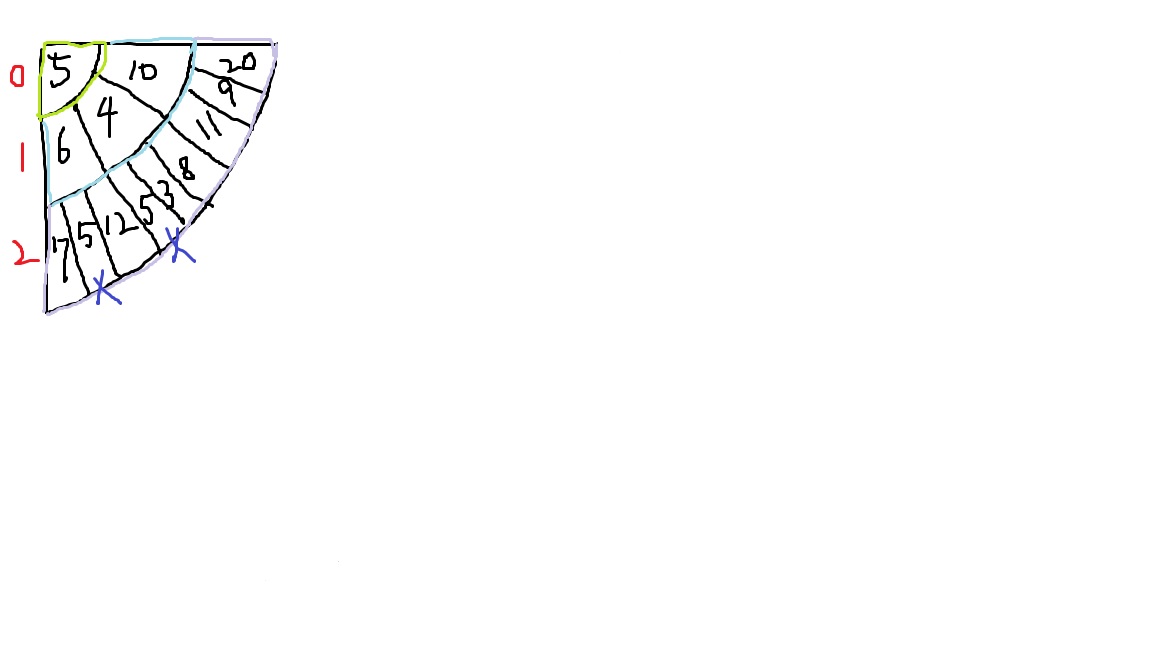https://www.acmicpc.net/problem/1697
문제 설명
수빈이의 위치는
N, 동생의 위치는K이다.
수빈이는 한 걸음에N+1,N-1,2N의 세 가지 방향으로 움직일 수 있다.
수빈이는 최소 몇걸음 만에 동생을 찾을 수 있는가?
문제 풀이
이 문제는 최소 걸음을 구해야 하므로 BFS로 풀어야 한다.
테스트케이스 예제로N = 5,K = 17이 주어졌다.
이렇게 쭉 나아가다 보면 4번째 걸음에서 17이 나와 종료될 것이다.
public static class StepInfo{
int nowN;
int step;
public StepInfo(int nowN, int step) {
this.nowN = nowN;
this.step = step;
}
}그래서 처음에 클래스 구조에 현재 위치
nowN과 현재 몇걸음인지 나타내는step을 선언했다.
// +1, -1, *2 셋 중 어느 연산을 할 건지 탐색
StepInfo nextInfo;
int tempN;
for(int d = 0; d < 3; d++) {
switch(d) {
case 0:
tempN = n;
tempN += 1;
nextInfo = new StepInfo(tempN, stepInfo.step + 1);
q.add(nextInfo);
break;
case 1:
tempN = n;
tempN -= 1;
nextInfo = new StepInfo(tempN, stepInfo.step + 1);
q.add(nextInfo);
break;
case 2:
tempN = n;
tempN *= 2;
nextInfo = new StepInfo(tempN, stepInfo.step + 1);
q.add(nextInfo);
break;
}
}그리고
+1-1*2세 가지 방향으로 나아가 큐에 쌓다가
if(n == K) {
System.out.println(stepInfo.step);
break;
}현재 위치
n이 동생의 위치K와 일치하면 정답을 출력하는 로직을 짰다.
그런데 이렇게 하면 메모리 초과가 나게 된다.
왜냐하면 위의 그림을 보게 되면5 > 6 > 5처럼, 왔던 수를 또 호출하는 경우가 생기기 때문이다.
우리는 최소 걸음을 구하는 것이기 때문에 이미 왔던 위치로 되돌아가면 절대 안된다.
static boolean[] check = new boolean[100001];따라서 다음과 같이
check배열을 할당하여 왔던 위치로 되돌아가지 않게 해줘야 한다.
전체 코드
package backJoon_1697_HideAndSeek;
import java.util.*;
/*
*
* 백준알고리즘
* 1697. 숨바꼭질
* https://www.acmicpc.net/problem/1697
* 2021-03-28
*
* */
public class Practice2 {
static int N;
static int K;
static boolean[] check = new boolean[100001];
public static class StepInfo{
int nowN;
int step;
public StepInfo(int nowN, int step) {
this.nowN = nowN;
this.step = step;
}
}
public static void main(String[] args) {
input();
StepInfo stepInfo = new StepInfo(N, 0);
Queue<StepInfo> q = new LinkedList<>();
q.add(stepInfo);
hideAndSeek(q);
}
private static void hideAndSeek(Queue<StepInfo> q) {
while(!q.isEmpty()) {
StepInfo stepInfo = q.poll();
int n = stepInfo.nowN;
if(n == K) {
System.out.println(stepInfo.step);
break;
}
// +1, -1, *2 셋 중 어느 연산을 할 건지 탐색
StepInfo nextInfo;
int tempN;
for(int d = 0; d < 3; d++) {
switch(d) {
case 0:
tempN = n;
tempN += 1;
if(tempN >= 0 && tempN < check.length && check[tempN] == false) {
nextInfo = new StepInfo(tempN, stepInfo.step + 1);
q.add(nextInfo);
check[tempN] = true;
}
break;
case 1:
tempN = n;
tempN -= 1;
if(tempN >= 0 && tempN < check.length && check[tempN] == false) {
nextInfo = new StepInfo(tempN, stepInfo.step + 1);
q.add(nextInfo);
check[tempN] = true;
}
break;
case 2:
tempN = n;
tempN *= 2;
if(tempN >= 0 && tempN < check.length && check[tempN] == false) {
nextInfo = new StepInfo(tempN, stepInfo.step + 1);
q.add(nextInfo);
check[tempN] = true;
}
break;
}
}
}
}
private static void input() {
Scanner sc = new Scanner(System.in);
N = sc.nextInt();
K = sc.nextInt();
}
}Git gist 주소
https://gist.github.com/ysyS2ysy/d63568b4a11c80732f8702df1a578b27


이 문제는 dfs로도 풀 수 있습니다. bfs의 오버헤드가 발생하지 않아 dfs가 더 빠를 수도 있습니다.